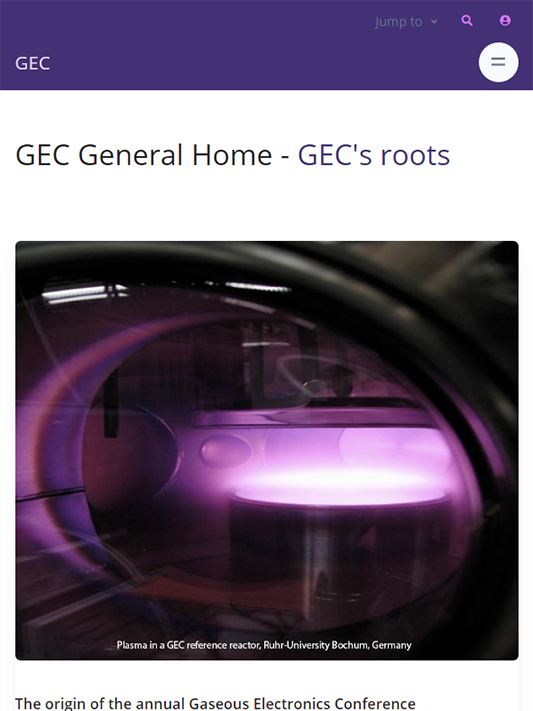The list of invited speakers (alphabetical) at the 2023 GEC in Ann Arbor, MI are as follows:
Alejandra Mendez, Instituto de Astronomía y Física del Espacio, Argentinia
Machine learning for modelling the electronic stopping power of ions
Allen Garner,Purdue University, USA
Gas breakdown theory and experiments: mechanistic transitions across length, pressure, and frequency scales
Anjana Devi, Ruhr University Bochum, Germany
Tuning precursors for plasma enhanced atomic layer deposition of functional materials
Aranka Derszi, Wigner Research Centre for Physics, Hungary
Electron power absorption in low-pressure capacitively coupled plasmas in gas mixtures
Bhagirath Ghimire, University of Alabama in Huntsville, USA
TBC
Connor Ballance, Queen's University of Belfast
A Dirac R-matrix approach in support of magnetically-confined plasma diagnostics
Costel Biloiu, Applied Materials, UK
Ion extraction optics for ion beam assisted etching applications
David Staack, Texas A&M University, USA
Dynamic processes in submerged plasmas
Deborah O'Connell, Dublin City University, Republic of Ireland
TBC
Erwin Kessels, Eindhoven University of Technology
Understanding and controlling the role of ions during plasma-enhanced ALD
Haomin Sun, Princeton University
Physical regimes of wave-wave nonlinear interactions generated by an electron beam
Hiromasa Tanaka, Nagoya University
Biomedical applications of plasma-activated solutions
Hyo-Chang, Lee, Korea Research Institute of Standards and Science, Rep. of Korea
electrically and optically measured plasma frequency
Igor Adamovich, The Ohio State University, USA
Associative Ionization Processes in Nonequilibrium Plasmas
Igor Kaganovich, Princeton University, USA
Two-dimensional modeling of capacitive discharges in magnetic field
James R. Danielson, UC San Diego, USA
Studies of positron binding and annihilation in benzene and other ring molecules
James Dedrick, University of York, UK
Reactive species production within inductively coupled hydrogen plasmas
Jaroslav Hofierka, Queen's University Belfast, UK
Many-body Theory of Positron Binding to Polyatomic Molecules
Jean-Paul Booth, LPP-CNRS, Ecole Polytechnique, France
An experimental study of oxygen atom surface recombination in plasmas: beyond the constant reaction probability model
Jianping Zhao, Research Science and SMTS Tokyo Electron America, USA
In-situ diagnostics for plasma enhanced ALD and CVD
João Santos Sousa, LPGP, CNRS & Univ. Paris-Saclay, France
Cold atmospheric plasmas in rare gas jets: from metastables species to biomedical and material applications
John P. Verboncoeur, Michigan State University, USA
Transition from multipactor discharge to microwave breakdown
Liang Xu, Soochow University, China
Rotating spokes in DC and RF driven low temperature magnetized plasmas
Lorenzo Ugo Ancarani, Université de Lorraine and CNRS, Metz, France
Ionization of molecules using a Gaussian representation of the continuum states
Maju Tomura, Tokyo Electron Miyagi Limited
State-of-the-art plasma etch process and technologies for high aspect ratio pattern
Marien Simeni Simeni, University of Minnesota, USA
Picosecond gas density measurements using the E-FISH diagnostics
Mark Zammit, Los Alamos National Laboratory, USA
General photon and electron collision approaches and models for kinetic modeling
Mark A. Cappelli, Stanford University, USA
On the use of non-magnetized and magnetized plasma metamaterials for novel control electromagnetic wave propagation
Michael Schulz, Missouri University of Science and Technology, USA
Non-PCI higher-order effects in fully differential ionization cross sections in p + He collisions
Milan Šimek, Institute of Plasma Physics of the Czech Academy of Sciences, Czech Republic
Nanosecond discharge in liquid water: signatures of underlying mechanisms
Nikola Skoro, Institute of Physics, University of Belgrade
Utilization of atmospheric pressure plasma reactivity for agricultural applications
Paola Diomede, Maastricht University, The Netherlands
Insight into contraction dynamics in CO2 microwave discharges through comparisons between simulations and experiments
Peng Zhang, Department of Electrical and Computer Engineering, USA
Modeling of surface electron emission with plasma interaction and space charge waves
Peter Bruggeman, University of Minnesota, U.S.A.
Interactions at the interface between atmospheric pressure plasmas and liquids
Phil Kraus, Applied Materials, USA
Characterization of overdense, large-area microwave plasmas
Richard Hofer, California Institute of Technology, USA
Electric propulsion at the Jet Propulsion Laboratory
Samantha Fonseca dos Santos, Rollins College, USA
Dissociation of Molecules by Low Energy Electron Impact
Sandra Ward Quintanilla, University of North Texas, USA
Electron-positronium scattering and the photodetachment of the positronium negative ion
Saravanapriyan Sriraman, Lam Research Corporation, USA
Plasma modeling and diagnostics in semiconductor equipment design
Sathya S. Ganta, Applied Materials, Inc., USA
A study of magnetic field effect in low pressure capacitively coupled plasma
Selma Mededovic Thagard, Clarkson University, USA
Removal of aqueous volatile organic compounds by electrical discharge plasma
Sergey Voronin, TEL Technology Center, USA
Ion and neutral transport through high aspect ratio features in plasma etch applications
Takehiko Sato, Tohoku University, USA
Inception and propagation processes of underwater streamer discharges
Timothy Gay, University of Nebraska, USA
Studies of chiral electron scattering by chiral molecules using a rb spin ex-change source
Tobias Gergs, Ruhr University Bochum, Germany
Scale-bridging simulations for plasma-surface interactions
Thomas Underwood, The University of Texas at Austin, USA
Air-breathing magneto-deflagration propulsion for sustained very low earth or-bit
Trevor Lafleur, ThrustMe, France
RF ICP discharges for electric propulsion applications
Vasco Guerra, Universidade de Lisboa, Portugal
Development of plasma-chemistry schemes: the call for a new paradigm
Viatcheslav Kokoouline, University of Central Florida, USA
Recent progress in theoretical description of excitation and dissociative processes in collisions of electrons with molecular ions
Yasunori Ohtsu, Saga University, Japan
Development of rotational RF magnetron sputtering plasmafor improving target utilization
Yiguang Ju, Princeton University, USA
Plasma assisted chemical looping and green manufacturing
Young-chul Ghim, KAIST, South Korea
Cross-field transport of low temperature plasmas around a magnetic X-point and the role of magnetic moment
Yuan-Hong Song, Dalian University of Technology, China
Hybrid simulations of instabilities in capacitively coupled RF CF4/Ar plasmas
Zaka-ul-Islam Mujahid, Ruhr University Bochum, Germany
Understanding and control streamer propagation, streamer-to-streamer streamer surface interactions in a patterned dielectric barrier discharge

